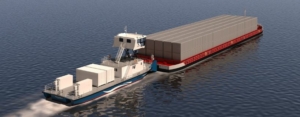Electric pusher vessel from WBE Klaipeda for shallow waters

Lithuanian ship designer Western Baltic Engineering (WBE) has unveiled designs for an electric pusher vessel intended for use on Europe’s inland waterways.
Western Baltic Engineering (WBE) operates within the Western Shipyard Group. The ship is to be built on the order of the Lithuanian Inland Navigation Office, a public body operating under the Lithuanian Ministry of Transport and Communications, next year.
WBE’s Head of Sales & Marketing Eglė Mikalauskienė, said the new vessel is designed to replace diesel pushers which presently dominate the market for ‘pushing’ non-propelled barges around Europe’s inland waterways.
“We are so excited to unveil this electric pusher design,” said Egle Mikalauskienė. “The Electric Eel has huge potential to help cut carbon emissions on inland waterways across Europe and worldwide. The idea came after we were approached by the Lithuanian Maritime Cluster to see if we could help the Lithuanian Inland Waterways authority create an eco-efficient pusher. The authority has big plans to ramp up the use of the 450km stretch of waterway between Klaipeda on the Baltic Sea to Kaunas to switch cargo from the road network in line with EU policy.”
– There are about 15,000 inland vessels in operation in the Rhine countries and over 3,000 ships in the Danube countries. 75.4% of all 3,214 ships in the Danube’s fleet are dry cargo ships (both types of barges), 18.3% are pusher ships or tugs, and 6.3% are liquid cargo ships, inform the authors of the INDanube project published in 2019 r.
The capacity of the Danube fleet is 3.4 million tonnes, 93% of which is dry and 7% liquid. Romania has the largest Danube fleet with 49.7% of the number of vessels and 54.1% of the total tonnage. The Romanian fleet was expanding until 2016. On the other hand, the fleets of other Danube countries – especially from Hungary, Slovakia and Serbia – are shrinking.
More: Marek Grzybowski: Lithuanian WBE electric pusher vessel
